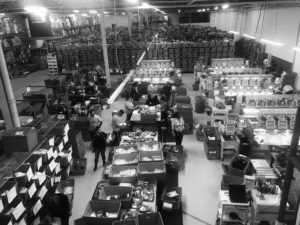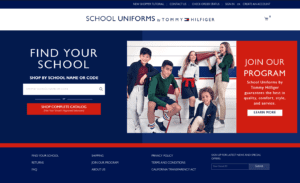Come back-to-school buying season, a 20,000-square-foot fulfillment center of apparel supplier Global Schoolwear runs up to a hectic pace as its crew of apparel stock handlers and embroidery specialists churn out thousands of logoed uniforms licensed by apparel brand Tommy Hilfiger for hundreds of schools.
Global Schoolwear’s goal, says chief operating officer Matt Kohls, is to provide the kind of uniform-purchasing experience that some schools can only provide online for the students and families that must go through the complicated task of ordering sets of approved apparel and accessories in the few months leading up to the start of fall classes. “School uniforms are pretty unique,” he says. “If customers go to a strip mall store, they’ll wait in a long line—and the store may or may not have what they need in stock. It’s not the best experience for the way customers expect to shop now.”
A supplier’s challenge: 200 types of plaid and many rules on logos
But providing a better purchasing experience online requires a complicated system of managing inventory according to Tommy Hilfiger’s and each school’s specifications—ranging from type of fabrics and colors to numerous rules about embroidering and placing school logos on garments. The options can seem limitless. In fabrics alone, “there are 200 types of plaid used by Catholic schools,” Kohls says.

Adam Weil, CEO, Global Schoolwear
Moreover, each school wants its own type of plaid skirt or cross-tie neckwear to go with particular sets of other garment colors—not to mention each school’s own set of logos, often in multiple sizes, patterns and garment placements designed differently for different grade levels. In some cases, school logos may be optional or are not even allowed on some types of garments. There also may be rules on how garments are hemmed.
And schools want it all available in a wide range of SKUs in multiple garment sizes—from toddler to adult, in many cases—within a short selling window of a few months before the start of classes.
A challenging business model
It’s an “interesting” but challenging business model to work with, says Adam Weil, CEO of Global Schoolwear, who is a former senior director in charge of the school uniforms unit at Lands’ End. “The interesting thing about this business model is that if there are 100 kids in a school, and we go 99 out of 100 in outfitting them, we still don’t win if just one kid is out of uniform. That’s one of our biggest challenges—to have enough of the right inventory available in real time for customers to order.”
But it’s a challenge that Global Schoolwear has learned to control with a customized digital commerce platform, Weil and Kohls say. Earlier this year, they put together a new technology framework designed to match thousands of buyers from hundreds of schools with just the right mix of Tommy Hilfiger garments according to the style, color and school logos each educational institution requires its students to wear.
1 million pieces in peak season
Global Schoolwear, which has an exclusive license from designer apparel brand Tommy Hilfiger to produce and sell school uniforms, has contracts with more than 450 schools to provide uniforms according to the specifications set by Tommy Hilfiger and by each school. Global Schoolwear takes Tommy Hilfiger’s garment specifications, then works with textile mills to produce the right garment materials in cotton and other fabrics, and works with apparel manufacturers to produce the garments.
It stocks enough goods in its warehouse-fulfillment center—about 1 million pieces at any one time during peak periods, with about 9,000 SKUs—to meet the expected overall back-to-school demand. As customers place orders on each school’s customized electronic product catalog that runs on Global Schoolwear’s ecommerce platform, each order is coded to indicate the garment type, style and color, plus the logo specifications.
But Kohls and Weil say they realized developing a customized online product catalog for each school, with coding to reflect their particular garment and logo requirements, would not be easy. They would need a highly flexible technology platform, and after looking at the technology market decided to go with a “headless” ecommerce approach from Amla Commerce and its Znode platform.
Why ‘headless’ worked for Global Schooolwear

Matt Kohls, chief operating officer, Global Schoolwear
Going “headless,” put simply, means that Znode comes with an ecommerce transaction engine that is not pre-designed with its own customer-facing front end or its own back-end business operations software or enterprise resource planning system. Instead, it comes with several hundred application programming interfaces, or APIs, that act as sets of software instructions on how two or more disparate software applications can automatically exchange data.
Although most, if not all, ecommerce platforms these days come with APIs, Znode provides a much larger than the average number of APIs designed for multiple purposes, such as integrating with content management and inventory management systems, Kohls says. In addition, its APIs are designed for specific tasks, such as sharing particular types of order information between the ecommerce engine and a customer-facing content management system.
While the Znode platform is built with APIs to allow its users to integrate the ecommerce engine with any external applications, it also uses its APIs to integrate with a Znode PIM, or product information management system, and a Znode CMS, content management system—giving companies that deploy the option to use Znode’s PIM and CMS, as well as external PIM and CMS applications if needed for particular purposes.
Knowing when to sew on a logo
In Global Schoolwear’s case, it uses the Znode PIM as a single product data management system to populate each school’s customized online product catalog. It also uses the Znode CMS to manage how it presents products in each customized catalog according to each school’s specifications.
In addition to managing each school’s requirements regarding garment styles and logos, Global Schoolwear’s ecommerce site must also be able to control when customers can add a garment to the online shopping cart based on whether their school requires a logo, makes one optional or disallows one for any type of clothing. “If the logo is required, you will not be able to add the item to your shopping cart without it,” Global Schoolwear’s ecommerce site informs its customers. “If the logo is optional, you will be given the choice to apply it or not. If the logo is not allowed, no logo option will appear.”
The Znode version 9.1 ecommerce platform from Amla Commerce updates Global Schoolwear’s Infoplus warehouse management system, from Infoplus Commerce, with information on each customer order. Warehouse workers view the details for each order on handheld devices, enabling them to pick the right garment and, if a logo is needed, bring it to the appropriate logo-embroidery machine set up with the school’s colors.
Getting orders right to avoid returns
The Infoplus system software integrates with the Pulse software that runs the embroidery machines, ensuring that each garment ordered with a logo gets the proper school emblem sewed onto it. The warehouse operates two types of embroidery sewing machines—one designed to embroider a school logo onto six garments simultaneously; the other designed to embroider a logo onto a single garment at a time for smaller orders. In all, the warehouse embroidery department can sew 54 logos at a time onto garments, resulting in a few thousand embroidered garments per day. Global Schoolwear also uses the Infoplus system to manage additional orders placed through Amazon.com.

Global Schoolwear’s warehouse and fulfillment center in Downer’s Grove, Illinois.
The complete order management and production system—from the customer-facing ecommerce sites to the warehouse management and embroidery machines—must work together to keep customers happy and avoid returns, Kohls says.
“When all the gears lock on this, five or six pieces of the puzzle fit together perfectly for customers to order the right product,” he says, adding: “40 to 50% of our whole year takes place in 40 to 60 days, so the system has to all work together.”
Custom product catalogs are ‘key’
To order uniforms, customers log onto their school’s custom catalog through GlobalSchoolwear.com. “The product catalogs are key,” says Shad Martin, who manages the warehouse and fulfillment center as head of distribution for Global Schoolwear. Without the customized product catalogs, he says, it would be difficult, if not impossible, for all students among the thousands who purchase the Tommy Hilfiger-branded uniforms to place orders within the four- to-five-month window of the back-to-school season—at least not without a lot of errors that can result in returns.
Without an effective online ordering method, placing orders either online or via telephone would have a higher likelihood of errors made during the customer’s ordering process, the production of garments or the order fulfillment. Errors would inevitably lead to returns from customers—not something a supplier of garments decorated with custom logos wants to deal with.
“Returns are a huge problem,” Martin says. If a logo comes out wrong, he adds, the company can’t just mark down the price and sell it to someone else.
Global Schoolwear, which is based in Milwaukee and operates its fulfillment center in the Chicago suburb of Downers Grove, Illinois, relies on a technology system that enables it to set up and manage product codes for each stock-keeping unit that it produces and makes available through each school’s customized online product catalog. After checking several options, they discovered the Znode system integrated well with the inventory management system.
A faster way to launch customized online catalogs
The Znode ecommerce platform replaced one from a different technology vendor, which had required Global Schoolwear to work with an outside web development team to launch a customized product catalog for each school. “This process took about a month to get the new school added, their products set up and their online store launched,” Kohls says.

The home page of GlobalSchoolwear.com.
But after all that work, customers trying place orders often found the product catalogs extremely slow to load—taking about five minutes—far too slow to provide a good customer experience and build sales, Weil adds.
On the new platform, Weil says, the product catalogs load instantly. And Global Schoolwear is now launching new product catalogs for schools “in approximately three days without a third-party development team,” Kohls says.
The API-based architecture of the Znode platform, he adds, enables Global Schoolwear to configure the product catalogs with customized school uniform-ordering rules with less software customization work. “While it did require some customization in Znode, it was nowhere near the level that would have been required in some other platforms,” Kohls says.
Now, when a school calls Global Schoolwear requesting to make a quick change to its product catalog—to add a new style of a light-blue polo with a special logo placement, for example—the company can make the change in about 15 minutes, compared with a week’s time under the old platform, Weil says.
Global Schoolwear didn’t comment on the cost of deploying its Znode technology. Tom Flierl, vice president of marketing and business development for Amla Commerce, says Amla positions Znode for mid-market companies with about $50 million or more in online revenue and charges an annual subscription with pricing tiers based upon annual online revenue. Znode offers both on-premise and single-tenant SaaS hosting; it does not take a percentage of revenue, he says.
Going forward, Weil and Kohls say they expect the flexibility and affordability of the new platform will continue to provide Global Schoolwear the ability to provide schools and the customers that buy their uniforms with the ease of purchasing they’ve come to demand.
In addition, Weil says there are more than 2,000 schools that require uniforms—and other markets, such as corporations in need of official garments with their own logos, for his company to consider serving through its new digital commerce technology. “We can scale on the Znode platform,” he says.
“I’ve been in business almost 20 years,” Weil adds. “And I’m always pushing to meet customers where they are.”
Sign up for a complimentary subscription to B2BecNews, published four times per week, covering technology and business trends in the growing B2B ecommerce industry. B2BecNews is a publication of DigitalCommerce360.com, whose titles also include Internet Retailer and Internet Health Management. Contact B2BecNews editor Paul Demery at [email protected] and follow him on Twitter @pdemery.
Follow us on LinkedIn and be the first to know when new B2BecNews content is published.
Favorite